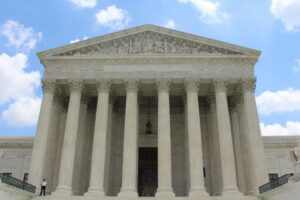 On Friday, June 27, the Supreme Court’s term closed and the Court handed down its final opinions, including in a case called Trump v. CASA. The CASA plaintiffs challenged President Trump’s executive order on birthright citizenship, but the Court’s decision – which made no substantive holdings about citizenship or immigration status – has far broader implications. Namely, it restricts federal courts from issuing most nationwide, or “universal,” injunctions. Effectively, the Court held that most lower court relief may not be applied more broadly than to the parties to the litigation itself. (The Court suggested that some injunctions might be made applicable to all individuals within a state if doing so provided relief, in the form of lessened administrative burden, to a state plaintiff. However, it did not formally opine on whether or in what circumstances this might be permissible.) The decision undoubtedly expands the scope of executive power and unalterably changes the way parties aggrieved by the federal government can fight back.
On Friday, June 27, the Supreme Court’s term closed and the Court handed down its final opinions, including in a case called Trump v. CASA. The CASA plaintiffs challenged President Trump’s executive order on birthright citizenship, but the Court’s decision – which made no substantive holdings about citizenship or immigration status – has far broader implications. Namely, it restricts federal courts from issuing most nationwide, or “universal,” injunctions. Effectively, the Court held that most lower court relief may not be applied more broadly than to the parties to the litigation itself. (The Court suggested that some injunctions might be made applicable to all individuals within a state if doing so provided relief, in the form of lessened administrative burden, to a state plaintiff. However, it did not formally opine on whether or in what circumstances this might be permissible.) The decision undoubtedly expands the scope of executive power and unalterably changes the way parties aggrieved by the federal government can fight back.
The new prohibition on nationwide injunctions will dramatically change the avenues local governments and community groups have to challenge the cancellation of or pause on federal grant awards under the Inflation Reduction Act (IRA) and the Infrastructure Investment and Jobs Act (IIJA). Before Friday, some federal awardees could rely on the preliminary injunctions issued in cases to which they are not parties. In other words, a small number of awardees challenged certain grant terminations, and where they were successful in receiving nationwide injunctions, other awardees under those same grant programs enjoyed the same legal protection as the named plaintiffs.
A handful of federal funding cases yielded preliminary injunctions that apply beyond the named plaintiffs. Two strike me as immediately vulnerable. First, the February 2025 preliminary injunction issued by the U.S. District Court for the District of Columbia in National Council of Nonprofits v. OMB. That injunction enjoined federal agencies from “implementing, giving effect to, or reinstating under a different name the unilateral, non-individualized directives in OMB Memorandum M-25-13.” The second at-risk injunction is the one issued by the U.S. District Court for the District of Rhode Island in Woonasquatucket River Watershed Council v. USDA, which blocked five federal agencies from “freezing, halting, or pausing” IRA grants on a “non-individualized basis.” It will take a few days to see how these preliminary injunctions are treated in the wake of Trump v. CASA, but I would expect that agencies will formally petition the courts to reverse or stay the existing injunctions. From a practical perspective, the National Council of Nonprofits injunction may not be particularly relevant at this stage, as agencies have largely stopped citing the Unleashing American Energy Executive Order (and the OMB Memo has been rescinded) as their source of authority for canceling grant awards, but the Woonasquatucket injunction is likely to have a more immediate impact to federal grantees under the applicable programs who are not named plaintiffs in that case.
Going forward, CASA means that many federal grantees will need to join litigation against the federal government as named plaintiffs in order to have a chance at reinstating their grants through the courts. As an alternative means to broad relief for non-named plaintiffs, the Supreme Court suggests class action lawsuits. Class actions provide a mechanism for one or a small number of plaintiffs to represent a larger group of parties that have experienced similar harms by the same defendants. They involve a formal process by which these similarly situated parties are certified as a “class” and are made formal parties to a litigation. Class actions will undoubtedly become more commonly used – within hours of the decision, counsel for the CASA plaintiffs had already filed to convert their underlying suit into one. They are, however, more cumbersome than most of the federal funding suits that have been filed to date, and certification as a class is not guaranteed. The upshot is that injunctive relief to reinstate federal grant terminations will become harder to achieve.
For local governments and other grantees that stand to lose out on injunctive relief as a result of the CASA decision, it will be important to adapt to the landscape. In particular, some local governments and community groups will likely become class members without asking to be included, or some instances without being aware of a class certification process taking place. While in many instances class actions will be a positive force providing an avenue for relief from federal agencies’ unlawful actions, becoming part of a class will also bring new rights and guardrails that will require legal guidance to navigate.
A good test case for the use of class actions to challenge the termination of federal funding awards to local governments and community groups is Appalachian Voices v. EPA, filed last week in the U.S. District Court for the District of Columbia. The case challenges grant terminations under Section 138 of the IRA, which includes the Thriving Communities Grantmaking Program, Community Change Grants, Environmental Justice Collaborative Problem Solving Cooperative Agreements, Government-to-Government Grants, and Thriving Communities Technical Assistance Centers (TC-TACs). The case has just under two dozen named plaintiffs (including six local governments), but their attorneys have identified 350 awardees under these programs. If the Appalachian Voices plaintiffs are successful in certifying a class, these 350 awardees (with some exceptions) will share in any relief granted to the named plaintiffs. Attorneys for the coalition filed a motion in support of class certification and a motion for preliminary injunction on Friday, June 27. Timing for class certification, if any, is uncertain.
As with many Supreme Court decisions, it will take time for CASA’s repercussions to become clear. In the near term, federal agencies may become more emboldened to interfere with or terminate grant awards that were protected by a court order. In the coming days and weeks, it is likely that more cases, both in the federal funding sphere and beyond it, will be filed as class actions. Federal grantees may also bring more one-off lawsuits, knowing that they cannot wait for a broad preliminary injunction from a case brought by another party. As for how class actions challenging federal award terminations fare, much remains to be seen. Class actions must comport with federal court rules, which will not allow for class certifications in all cases, and one of the concurring opinions in CASA warns that lower courts “should not view [the CASA] decision as an invitation to certify nationwide classes without scrupulous adherence to” federal rules. To put it another way, the usefulness of class action lawsuits depends on the willingness of a trial court to certify a class, and we’re likely to see related questions play out in the courts for years to come.




